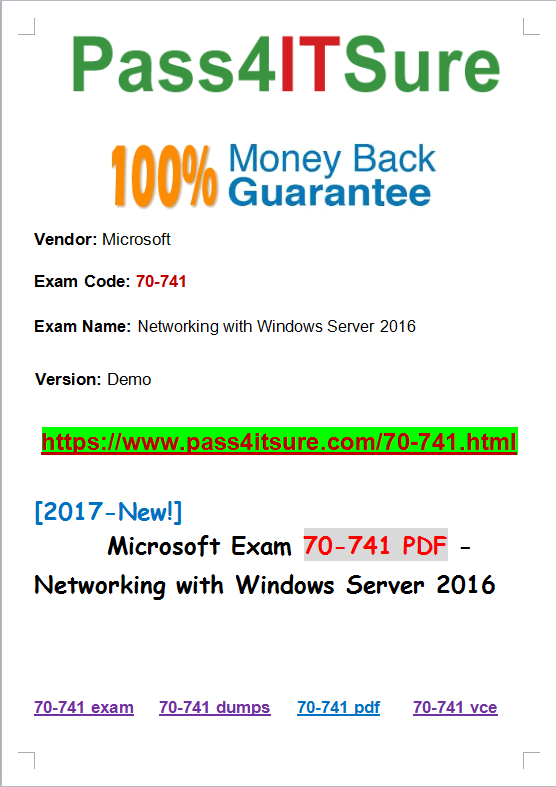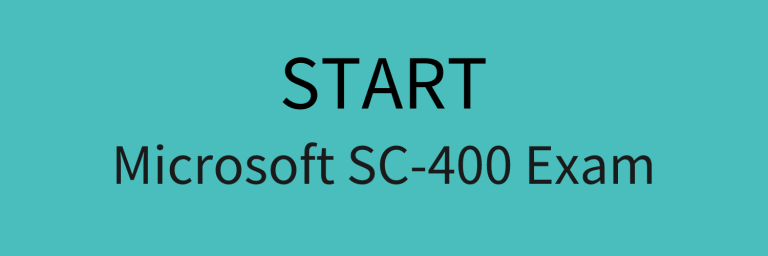Any suggestions on passing the Microsoft 70-741 dumps? “Networking with Windows Server 2016” is the 70-741 exam dumps which covers all the knowledge points of the real Microsoft exam. Helpful Microsoft 70-741 dumps pdf exam certification are based on the real exam video study. Pass4itsure 70-741 dumps exam questions answers are updated (48 Q&As) are verified by experts. Pass4itsure https://www.pass4itsure.com/70-741.html dumps pdf questions are always kept up-to-dated and redesigned when mechanical advances and Microsoft Networking with Windows Server 2016 exam significance techniques change.
Exam Code: 70-741
Exam Name: Networking with Windows Server 2016
Updated: Sep 05, 2017
Q&As: 48
[2017-NEW! Microsoft 70-741 Dumps From Google Drive]: https://drive.google.com/open?id=0BwxjZr-ZDwwWWU9QM0NyNGN1cFU
[2017-NEW! Cisco 210-260 Dumps From Google Drive]: https://drive.google.com/open?id=0BwxjZr-ZDwwWU0xad3NvRWR4Qzg
This Microsoft Exam:
• Features strategic, what-if scenarios to challenge you
• Points to in-depth material by topic for exam candidates needing additional review
• Assumes you are an IT pro looking to validate your skills in and knowledge of Microsoft 70-741 dumps installing and configuring Windows Server 2016

Pass4itsure Latest and Most Accurate Microsoft 70-741 Dumps Exam Q&As:
QUESTION NO: 23
What happens when you attempt to compile and run the following code?
#include <iostream>
#include <string>
using namespace std;
class A {
int x;
protected:
int y;
public:
int z;
A() { x=1; y=2; z=3; }
};
class B : public A {
string z;
public:
void set() {
y = 4;
z = “John”;
}
void Print() {
cout << y << z;
}
};
int main () {
B b;
b.set();
b.Print();
return 0;
}
A. It prints: 4John
B. It prints: 2John
C. It prints: 23
D. It prints: 43
70-741 exam Answer: A
QUESTION NO: 24
What happens when you attempt to compile and run the following code?
#include <iostream>
#include <string>
using namespace std;
const int size = 3;
class A {
public:
string name;
A() { name = “Bob”;}
A(string s) { name = s;}
A(A &a) { name = a.name;}
};
class B : public A {
public:
B() { }
B(string s) : A(s) { }
void Print() {
cout << name;
}
};
int main () {
B b1(“Alan”);
b1.Print();
return 0
}
A. It prints: 111Alan
B. It prints: Bob
C. It prints: Alan
D. It prints: 0
Answer: C
QUESTION NO: 25
What is the output of the program given below?
#include <iostream>
using namespace std;
int main (int argc, const char * argv[])
{
int i=10;
{
int i=0;
cout<<i;
}
{
i=5;
cout << i;
}
cout<<i;
return 0;
}
A. 1010
B. 101010
C. 055
D. None of these
Answer: C
QUESTION NO: 26
What happens when you attempt to compile and run the following code?
#include <iostream>
using namespace std;
int main (int argc, const char * argv[])
{
int x,y;
union t
{
char tab[2];
int i;
};
union t u;
u.tab[0] = 1;
u.tab[1] = 2;
u.i = 0;
x = u.tab[0];
y = u.tab[1];
cout << x << “,” << y << “,” << u.i;
return 0;
}
A. compilation fails
B. It prints: 0,0,0
C. It prints: 1,2,0
D. None of these
70-741 dumps Answer: B
QUESTION NO: 27
What happens when you attempt to compile and run the following code?
#include <iostream>
#include <string>
using namespace std;
class A {
protected:
int y;
public:
int x,z;
A() : x(1), y(2), z(0) { z = x + y; }
A(int a, int b) : x(a), y(b) { z = x + y;}
void Print() { cout << z; }
};
class B : public A {
public:
int y;
B() : A() {}
B(int a, int b) : A(a,b) {}
void Print() { cout << z; }
};
int main () {
A b;
b.Print();
return 0;
}
A. It prints: 3
B. It prints: 0
C. It prints: 1
D. It prints: 2
Answer: A
QUESTION NO: 28
Which code, inserted at line 10, generates the output “Hello World”?
#include <iostream>
#include <string>
using namespace std;
string fun(string, string);
int main()
{
string s=”Hello”;
string *ps;
ps = &s;
//insert code here
return 0;
}
string fun(string s1, string s2)
{
return s1+s2;
}
A. cout << fun(” World”);
B. cout << fun(*ps);
C. cout << fun(“Hello”);
D. cout << fun(“Hello”, ” World”);
70-741 pdf Answer: D
QUESTION NO: 29
What happens when you attempt to compile and run the following code?
#include <iostream>
using namespace std;
int x=5;
static int y=0;
void myFunction(int a)
{
y=++a;
}
int main (int argc, const char * argv[])
{
int i=0;
myFunction(i);
cout<<y<<” “<<x;
}
A. It prints: 0 5
B. It prints: 5 1
C. It prints: 1 5
D. It prints: 5 0
Answer: C
QUESTION NO: 30
C++ Institute CPA Exam
What happens when you attempt to compile and run the following code?
#include <iostream>
using namespace std;
class A {
public:
void Print(){ cout<<“A”; }
};
class B:public A {
public:
virtual void Print(){ cout<< “B”; }
};
class C:public B {
public:
void Print(){ cout<< “C”; }
};
int main()
{
A ob1;
B ob2;
C ob3;
A *obj;
obj = &ob1;
obj?>Print();
obj = &ob2;
obj?>Print();
obj = &ob3;
obj?>Print();
}
A. It prints: BBB
B. It prints: AAA
C. It prints: ABC
D. It prints: ABB
70-741 vce Answer: B
QUESTION NO: 31
What happens when you attempt to compile and run the following code?
#include <iostream>
#include <string>
using namespace std;
class A {
public:
int x;
};
class B : public A {
public:
B() { x=1;}
B(int x) {this?>x = x;}
};
int main () {
B c1;
B c2(10);
cout << c1.x;
cout << c2.x;
return 0;
}
A. It prints: 010
B. It prints: 110
C. It prints: 00
D. It prints: 1
Answer: B
QUESTION NO: 32
What happens when you attempt to compile and run the following code?
#include <iostream>
using namespace std;
void fun(char*);
int main()
{
char t[4]={‘0’, ‘1’, ‘2’, ‘3’};
fun(&t[2]);
return 0;
}
void fun(char *a)
{
cout << *a;
}
A. It prints: 2
B. It prints: 21
C. It prints: 00
D. It prints: 02
70-741 exam Answer: A
QUESTION NO: 33
What happens when you attempt to compile and run the following code?
#include <iostream>
#include <string>
using namespace std;
class A {
public:
A() { cout << “A no parameters”;}
A(string s) { cout << “A string parameter”;}
A(A &a) { cout << “A object A parameter”;}
};
class B : public A {
public:
B() { cout << “B no parameters”;}
B(string s) { cout << “B string parameter”;}
};
int main () {
A a2(“Test”);
B b1(“Alan”);
B b2(b1);
return 0;
}
A. It prints: A no parametersA no parametersB string parameter
B. It prints: A string parameterA no parametersB string parameterA object A parameter
C. It prints: A no parametersB string parameter
D. It prints: A no parametersA no parameters
Answer: B
QUESTION NO: 34
What happens when you attempt to compile and run the following code?
#include <iostream>
#include <string>
using namespace std;
class A {
public:
string s;
A(string s) { this?>s = s; }
};
class B {
public:
string s;
B (A a) { this?>s = a.s; }
void print() { cout<<s; }
};
int main()
{
A a(“Hello world”);
B b=a;
b.print();
}
A. It prints: Hello world
B. It prints: Hello
C. Compilation error
D. None of these
70-741 dumps Answer: A
QUESTION 35
Where are the core module translations located?
A. app/code/locale/
B. app/locale/
C. app/design/frontend/default/default/locale/
D. app/etc/modules/locale/
Correct Answer: B
QUESTION 36
Layered navigation is displayed for a specific category when _________?
A. layered navigation is enabled in System-> Configuration-> Catalog
B. the category contains products with filterable attributes
C. “Is Anchor” is set to “Yes” in the category settings
D. custom layout update XML adds the layered navigation block
70-741 pdf Correct Answer: C
QUESTION 37
What is the function of the attribute output= “to Html” when applied to a <block> tag?
A. Renders a block without any other explicit calls
B. Specifies the sequence of blocks on the page
C. Marks a block as a structural block
D. Marks a block as a content block
Correct Answer: A
QUESTION 38
Given the information shown below, which answer will correctly assign a customized template file using
layout XML?
Block type:
example/controller
Template path:
/a pp/design/frontend/base/exampletheme/examplefolder/example.phtml
A. <template block type=”example/ controller” name= “example” as=”example1′ file path=”examplefolder/
example.phtml”/ >
B. <block name=”example/controller” template=”examplefolder/example.phtml” />
C. <block type=”example/controller” name=”example” as=”example” template=”examplefolder/
example.phtml” />
D. <reference name=”example/controller” as “example” template=”examplefolder/example.phtml” />
70-741 vce Correct Answer: C
QUESTION 39
Which one of the following methods assigns a custom template to the product compare sidebar block?
A. Option A
B. Option B
C. Option C
D. Option D
Correct Answer: A
QUESTION 40
In layout XML, which two handles are used to assign layout rules to catalog category pages of a store?
(Choose TWO.)
A. <catalog_category>
B. <catalog_layered>
C. <catalog_category_default>
D. <catalog_category_index>
E. <catalog_category_layered>
70-741 exam Correct Answer: CE
Hence, we take awesome care while setting up our MCSA exam will lead you to better vocation prospects. Microsoft Windows Server 2016 70-741 dumps pdf questions study material give you best quality Microsoft Networking with Windows Server 2016 exam to help you pass the MCSA and be a https://www.pass4itsure.com/70-741.html dumps ensured proficient.





